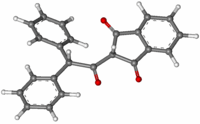Diphenadione
| Diphenadione | |
|---|---|
 | |
 | |
| IUPAC name 2-(Diphenylacetyl)-1H-indene-1,3(2H)-dione | |
| Other names Diphacinone; Diphenandione | |
| Identifiers | |
| CAS number | 82-66-6 |
| PubChem | 6719 |
| ChemSpider | 6463 |
| UNII | 54CA01C6JX |
| KEGG | D07136 |
| ChEMBL | CHEMBL1413199 |
| ATC code | B01 |
| Jmol-3D images | Image 1 |
| |
| |
| Properties | |
| Molecular formula | C23H16O3 |
| Molar mass | 340.37 g mol−1 |
| Except where noted otherwise, data are given for materials in their standard state (at 25 °C (77 °F), 100 kPa) | |
| Infobox references | |
Diphenadione is a vitamin K antagonist which has anticoagulant effects and is used as a rodenticide against rats, mice, voles, ground squirrels and other rodents. This chemical compound is an anti-coagulant with longer activity than warfarin and other synthetic indandione anticoagulants.[1]
Safety and toxicity
Diphenadione is highly toxic for human skin by all means of contact. The consumption of drug may cause major blood clotting and irregular heartbeats.[2] An online pesticide database gives more information about the safety of diphenadione.[3] The U.S. Environmental Protection Agency has issued a safety handbook which explains how incidents of poisoning with similar rodenticides are usually treated.[4] For treatment purposes Vitamin K antagonists like diphenadione are placed under the heading of coumarins and indandiones. The handbook notes that "...as agents specifically designed to kill mammals, often their toxicity is very similar for the target rodents and for humans."[5]
References
- ↑ "Diphacinone". Pmep.cce.cornell.edu. Retrieved 2011-12-07.
- ↑ Bell Laboratories, Inc. July, 1990. Diphacinone Technical: MSDS. Bell Labs, Madison, WI.
- ↑ "Diphacinone - toxicity, ecological toxicity and regulatory information". Pesticideinfo.org. Retrieved 2011-12-07.
- ↑ Routt Reigart and James Roberts (1999). Recognition and management of pesticide poisonings (5th edition). USEPA.
- ↑ Reigart, page 169.
| |||||||||||||||||||||||||||||||||||||||||||||||||||||||
| |||||||||||||||||||||||||||||||||||||||